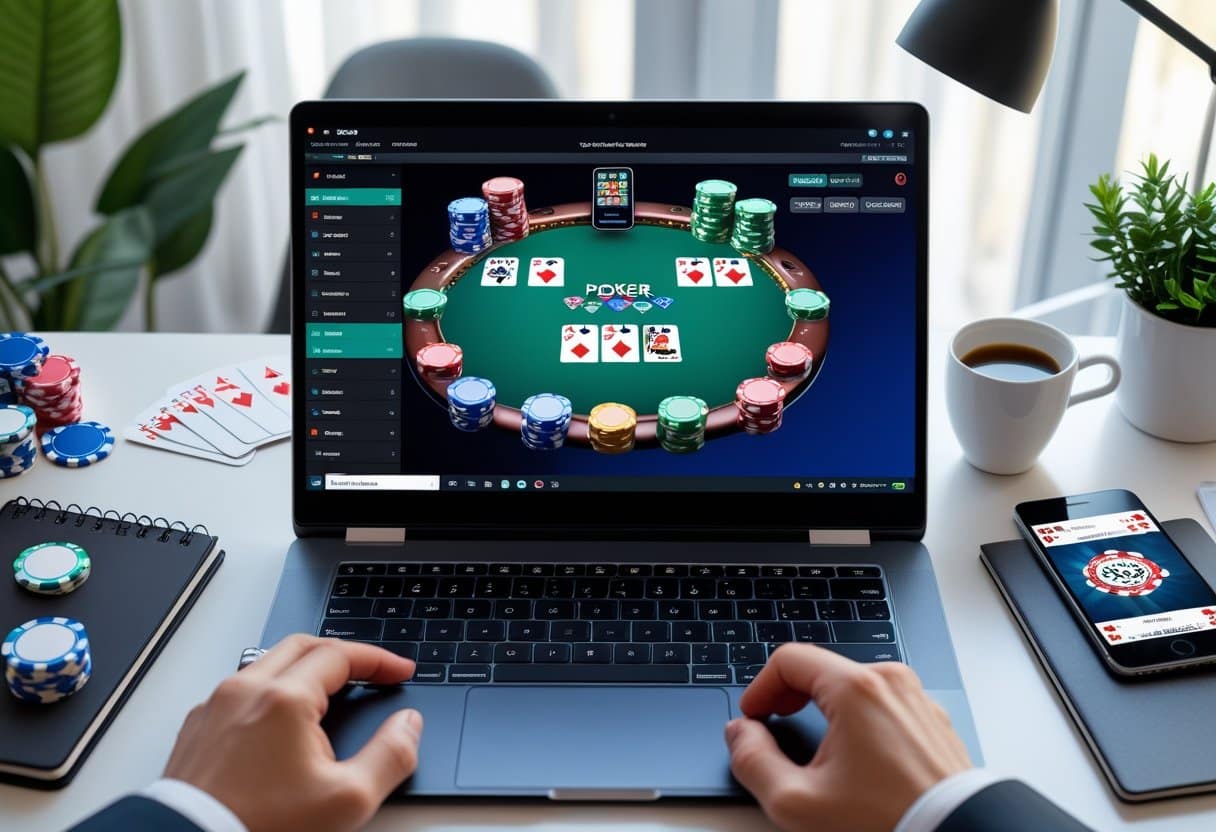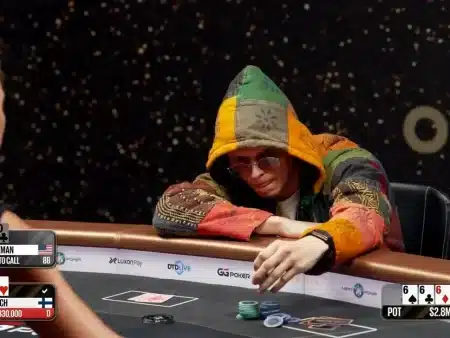Online poker’s really evolved lately, hasn’t it? In 2025, you’ve got all sorts of advanced software at your fingertips, analyzing nearly every situation, plus a ridiculous amount of free content to help you up your game.
It’s kind of a double-edged sword though—learning is easier, but the competition’s gotten fierce.

If you’re aiming for poker success in 2025, it all starts with nailing the basics at micro stakes before climbing the ladder. So many beginners get tempted by fancy plays or higher stakes before they’re ready. Honestly, most pros will tell you to keep it simple at first—stick to a tight and aggressive style, and don’t worry about the advanced stuff just yet.
A solid study routine really pays off if you’re serious about improving. The best players these days mix regular practice with focused study sessions every week.
They’ll review their hands, patch up leaks, and keep learning new concepts to stay ahead of the curve.
Getting Started With Online Poker

Jumping into online poker? You’ll want to make a few smart choices right off the bat.
The platform, game type, and how you set up your account can really shape your first experiences.
Choosing the Right Poker Platform
Picking a trustworthy poker site is crucial. PokerStars is still a top pick in 2025 thanks to its reliable software and massive player pool.
Always check for licensing and strong security—protecting your money and info is non-negotiable.
Traffic matters more than you might think. More players means more games, which is super handy if you play at weird hours.
Don’t forget to look at the bonuses. New player promos, free tournament tickets, and deposit matches can give your bankroll a nice little boost.
How the site feels counts too. Go for something with a clean, easy-to-use design that works well on whatever device you use most.
Understanding Poker Variants
Texas Hold’em is still the king of online poker. If you’re new, it’s the best place to start—simple rules and tons of guides everywhere.
Other variants worth mentioning:
- Omaha: You get four hole cards instead of two.
- Seven-Card Stud: There are no community cards; everyone builds their hand from seven dealt cards.
- Short Deck: Played without 2-5 cards, which ramps up the action.
Each game has its own quirks and strategies. Start with Hold’em, get the basics down, then branch out if you want.
Micro-stakes tables (think $0.01/$0.02 blinds) are perfect for learning. You won’t risk much, but you’ll get real experience.
Creating Your Poker Account
Getting set up is usually quick. You’ll provide some basic info and verify your identity—standard stuff for regulations.
A few security musts:
- Use a strong, unique password.
- Turn on two-factor authentication if you can.
- Never share your login details.
For deposits, stick to trusted options like credit cards, e-wallets, or bank transfers. Start small—only what you’re comfortable losing.
Play money games are a great way to get the hang of things. They’re free, so you can figure out the software and basics before risking anything real.
Fundamental Poker Strategies for Beginners
If you want to go far, you need a solid foundation. Mastering the basics helps you dodge rookie mistakes and build smart habits from the start.
Essential Poker Rules and Hand Rankings
You can’t really play if you don’t know the hand rankings. Royal flush is tops, then straight flush, four of a kind, full house, flush, straight, three of a kind, two pair, one pair, and finally high card.
Seriously, memorize these before you play for money. In Hold’em, you get two private cards and share five on the board.
The betting goes in rounds: pre-flop, flop, turn, then river. Each round, you decide to check, bet, call, raise, or fold.
You win either by having the best hand at showdown or getting everyone else to fold. That’s the gist.
Position and Table Awareness
Position is one of those things beginners overlook, but it’s a huge deal. Players act clockwise—early, middle, and late positions.
Why position matters:
- Acting later means you see what others do first.
- More info = better decisions.
- You can steal blinds more often in late position.
- Early spots? Only play strong hands.
Pay attention to who’s aggressive or passive, loose or tight. The makeup of your table changes everything.
If you spot players who call too much, just value bet your good hands and ease up on the bluffs.
Mastering the Tight and Aggressive Strategy
The tight-aggressive (TAG) style is the gold standard for beginners. Basically:
- Only play strong starting hands.
- When you do play, play hard—raise, don’t just call.
Why it works:
- Keeps you out of tricky spots after the flop.
- Makes you look like you mean business.
- You get max value from your best hands.
- You lose less with the junk.
Stick to the top 15-20% of hands—big pairs, big aces, some suited connectors. If you’re in, come in raising.
Don’t fall into the trap of playing too many hands in early position. Save the weaker stuff for late spots where you have more info.
Utilizing a Poker Cheat Sheet
A cheat sheet is a lifesaver when you’re starting out. Keep one handy with:
- Starting hand charts for each position.
- A pot odds calculator.
- Position tips.
- Common betting patterns and what they might mean.
Lots of sites offer printable cheat sheets for beginners. Use yours while you play—it’s great for building good habits.
The more you play, the less you’ll need it. Eventually, you’ll just know what to do.
Just remember, a cheat sheet is a guide, not gospel. As you get better, you’ll start spotting times when it’s right to break the “rules.”
Developing Advanced Poker Skills
Once you’ve got the basics down, it’s time to level up. The real difference-makers? Bluffing, game theory, and managing your bankroll like a pro.
Effective Bluffing Techniques
Bluffing is kind of an art. When it works, it feels great, but you can’t just do it randomly.
Think about how you look at the table—tight players get away with more bluffs because people believe them. If you’re seen as wild, expect more calls.
Bluff when the board makes your story believable. If there’s a possible straight or flush, that’s a good time to represent it.
Timing is everything. Bluffing from late position is usually better since you see what everyone else does first.
Look for opponents who fold a lot—those are your best bluffing targets.
Applying Game Theory to Poker
Game theory sounds intimidating, but it’s just a way to make your decisions less predictable.
Game Theory Optimal (GTO) play means having the right mix of value bets and bluffs so others can’t easily read you.
Some key ideas:
- Minimum Defense Frequency: How often you should call so people can’t just bluff you all day.
- Bet sizing: Mixing up your bet sizes for different goals.
- Range construction: Building a balanced mix of hands for each situation.
There are tools (like solvers) that show you GTO solutions for common spots. They’re cool for study, but honestly, you don’t need to play perfect GTO at low stakes.
Bankroll Management for Winning Consistently
Even if you’re a great player, without bankroll management, you’re toast. Poker has swings—sometimes brutal ones.
A good rule? Keep 20-50 buy-ins for whatever stakes you’re playing. Tournaments are swingier, so you’ll want even more.
Track your results with software or a spreadsheet. It’ll help you spot leaks and keep your emotions in check.
Move up in stakes only when your bankroll says it’s safe, not just because you had a good night. Maybe bump up when you hit 30+ buy-ins for the next level, and drop back if you fall below 20.
Taking shots at bigger games? Keep it to a small chunk of your bankroll so you don’t blow everything.
Excelling in Specific Online Poker Formats
Each poker format has its own quirks. Knowing how to adjust your strategy is key if you want to crush it.
Strategies for Cash Games
Cash games are great if you like flexibility. You can come and go as you please, and the blinds don’t change.
Some quick tips:
- Buy in for the max (usually 100 big blinds) so you can take full advantage of your edge.
- Push your position when others are passive.
- Value bet thinly when you think you have the best hand.
- Focus on your long-term win rate, not just tonight’s results.
Track your hourly rate at different stakes to see where you’re making the most. A lot of pros suggest starting with cash games before mixing in other formats.
Table selection matters. Find tables with a couple of recreational players—it’s a much easier way to win.
Climbing the Stakes: From Low to Small Stakes Poker
Moving up is exciting, but you need both the bankroll and the skills.
Recommended bankrolls for each level:
| Stake Level | Minimum Bankroll (100BB buy-ins) |
|---|---|
| NL2 (2¢/5¢) | $60 (30 buy-ins) |
| NL5 (5¢/10¢) | $150 (30 buy-ins) |
| NL10 (10¢/25¢) | $300 (30 buy-ins) |
| NL25 (25¢/50¢) | $750 (30 buy-ins) |
At the lowest stakes, just play solid, straightforward poker. As you move up, you’ll need to mix up your play and read hands better.
Don’t rush it. Some players move up too fast and lose confidence. Wait until you’ve got a solid sample size (say, 25,000+ hands) of consistent wins before taking the next step.
Adjusting to Different Player Types
Spotting different player types—and knowing how to exploit them—is a huge edge.
The usual suspects:
- TAG (Tight-Aggressive): Not many hands, but aggressive when they play.
- LAG (Loose-Aggressive): Lots of hands, lots of aggression.
- Nits: Ultra-tight, rarely bluff.
- Calling Stations: Call too much, rarely fold.
- Maniacs: Overly aggressive, always raising.
Against nits, just value bet and don’t bother bluffing much. With calling stations, go for value and skip the fancy bluffs.
LAGs? Tighten up and let them make mistakes.
Take notes and use HUD stats (if your site allows it) to track tendencies. VPIP and PFR are your friends for quick reads.
Bad players often have obvious patterns—especially in their bet sizing. Keep an eye out for that.
Responsible Gambling and Sustainable Success
Online poker’s a blast, but you need balance. The best players mix sharp skills with responsible habits and a focus on security.
Setting Limits and Avoiding Tilt
Set boundaries before you play—both time and money. Only risk what you can afford to lose, no exceptions.
Most sites have tools to limit your deposits, losses, or session times. They’re there for a reason—use them.
Variance is part of the game. Even great players hit losing streaks. That’s why bankroll management is so important.
Watch for tilt:
- Suddenly betting bigger.
- Playing way too many hands.
- Chasing after losses.
- Feeling angry or frustrated.
If you catch yourself slipping, just take a break. A little distance can save you a lot of money and stress.
Staying Safe and Secure Online
When it comes to picking a poker site, stick to platforms that have solid reputations and the right licensing. It’s honestly worth taking the time to dig into reviews and double-check a site before handing over your cash or personal details.
Security best practices:
- Go for strong, unique passwords—don’t just recycle the same old ones.
- Turn on two-factor authentication if it’s offered. It’s a hassle, but it works.
- Try to play only on secure, private networks. Public WiFi? I’d skip it.
- Keep your software up to date. Those updates matter more than people think.
Be careful with your personal info. Real poker sites won’t hit you up for weird details or ask for sensitive stuff by email, so that’s a red flag if you see it.
Keep an eye out for anything odd on your accounts. It’s smart to check your statements now and then, and if you spot something off, don’t wait—report it right away.
Some folks like to use a separate email and payment method just for poker. Not a bad idea, honestly; it adds a little buffer if something ever goes sideways.













